Enterprise Architecture Report: Steelco, Multicorp & Fincorp Analysis
VerifiedAdded on 2023/01/11
|10
|3100
|33
Report
AI Summary
This report provides an in-depth analysis of enterprise architecture (EA) through three case studies: Steelco, Multicorp, and Fincorp. It examines how Steelco should structure its architecture functions, determining the number of architects needed for each position and the operating models of Multicorp's strategic units, including standardized business processes and integrated data across its units. The report also investigates the IT landscape of these companies. Furthermore, it evaluates the effectiveness of installed EA tools at Fincorp, identifying shortcomings and suggesting improvements for business and IT alignment, including how the tool can facilitate decision-making, risk management, and IT management, and how EA can be aligned with other business units to improve investment decisions.
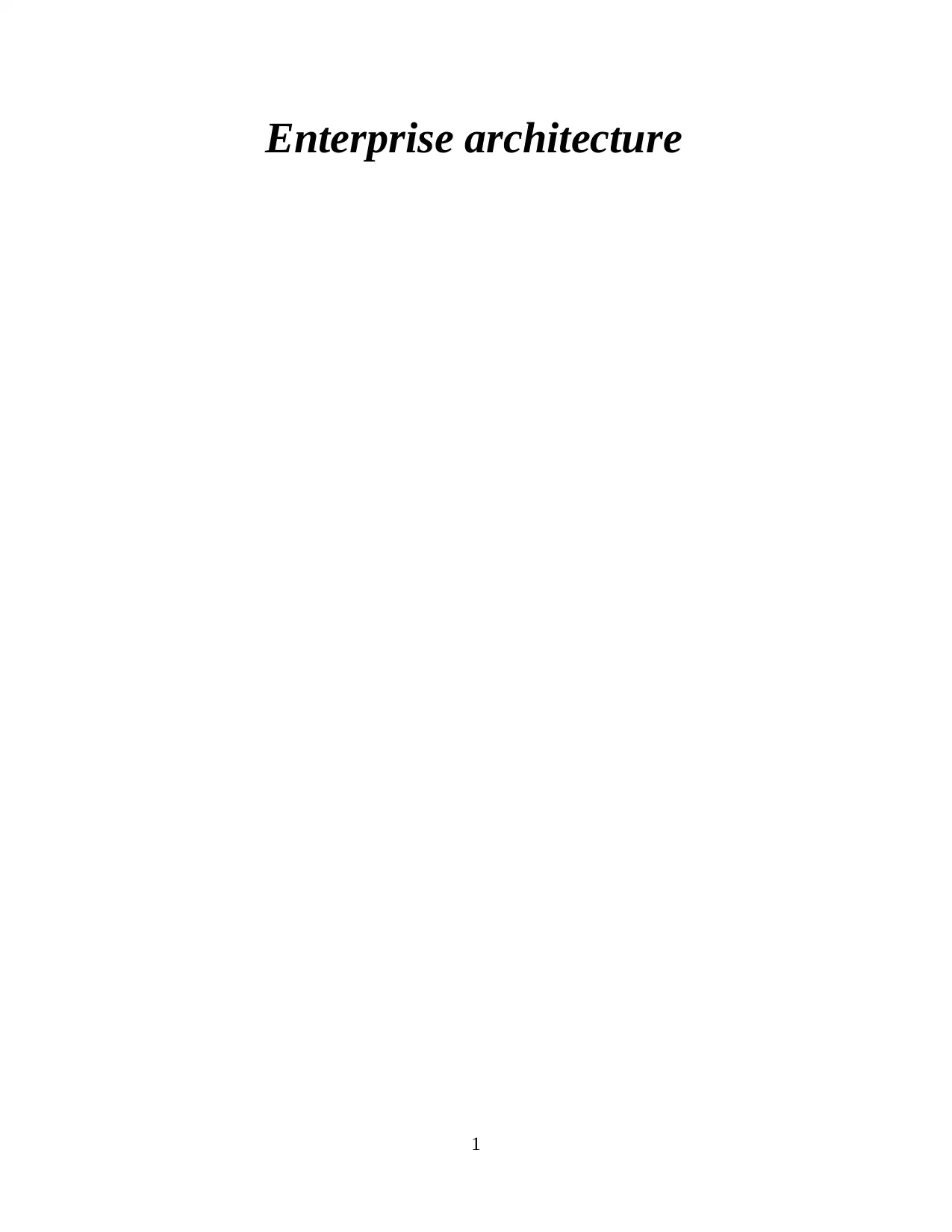
Enterprise architecture
1
1
Paraphrase This Document
Need a fresh take? Get an instant paraphrase of this document with our AI Paraphraser
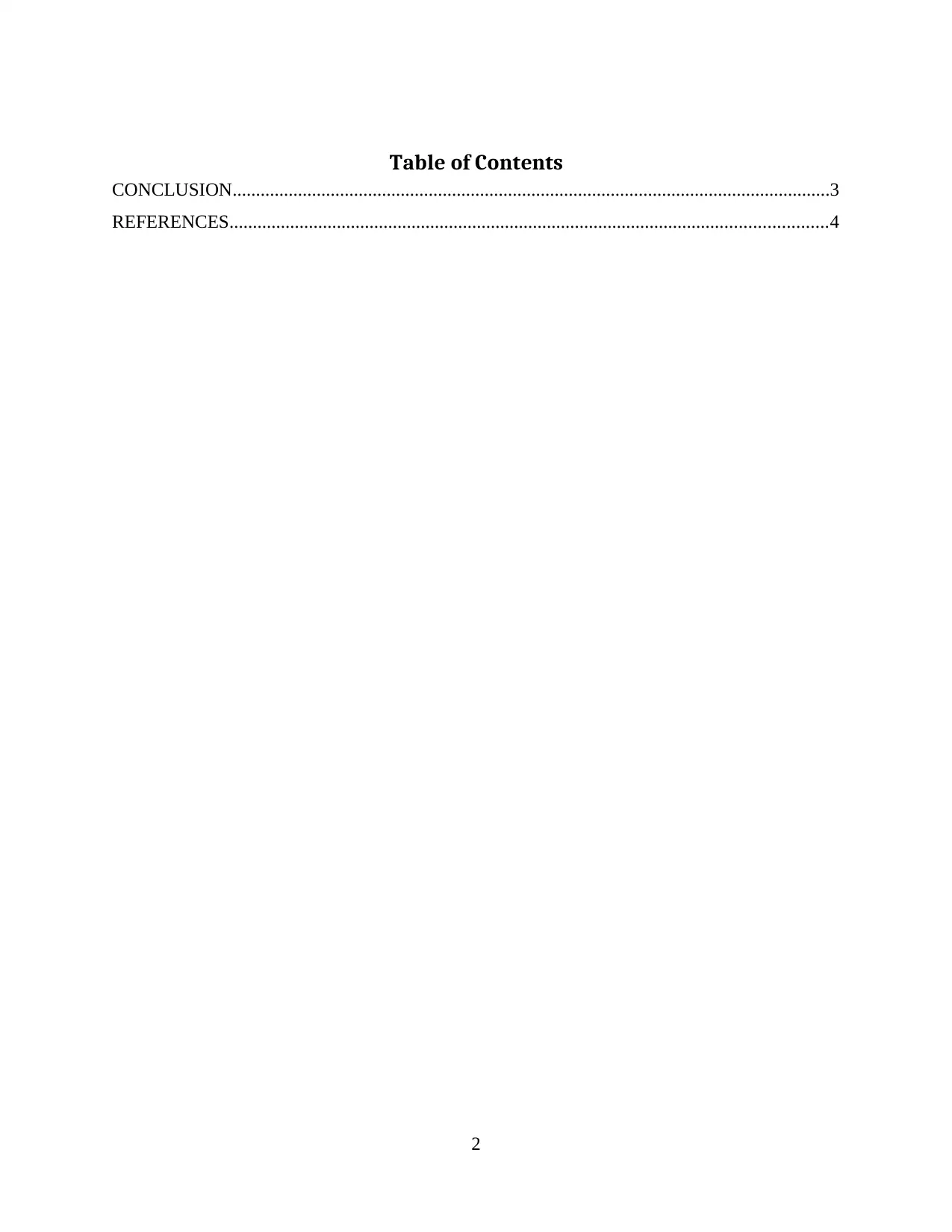
Table of Contents
CONCLUSION................................................................................................................................3
REFERENCES................................................................................................................................4
2
CONCLUSION................................................................................................................................3
REFERENCES................................................................................................................................4
2
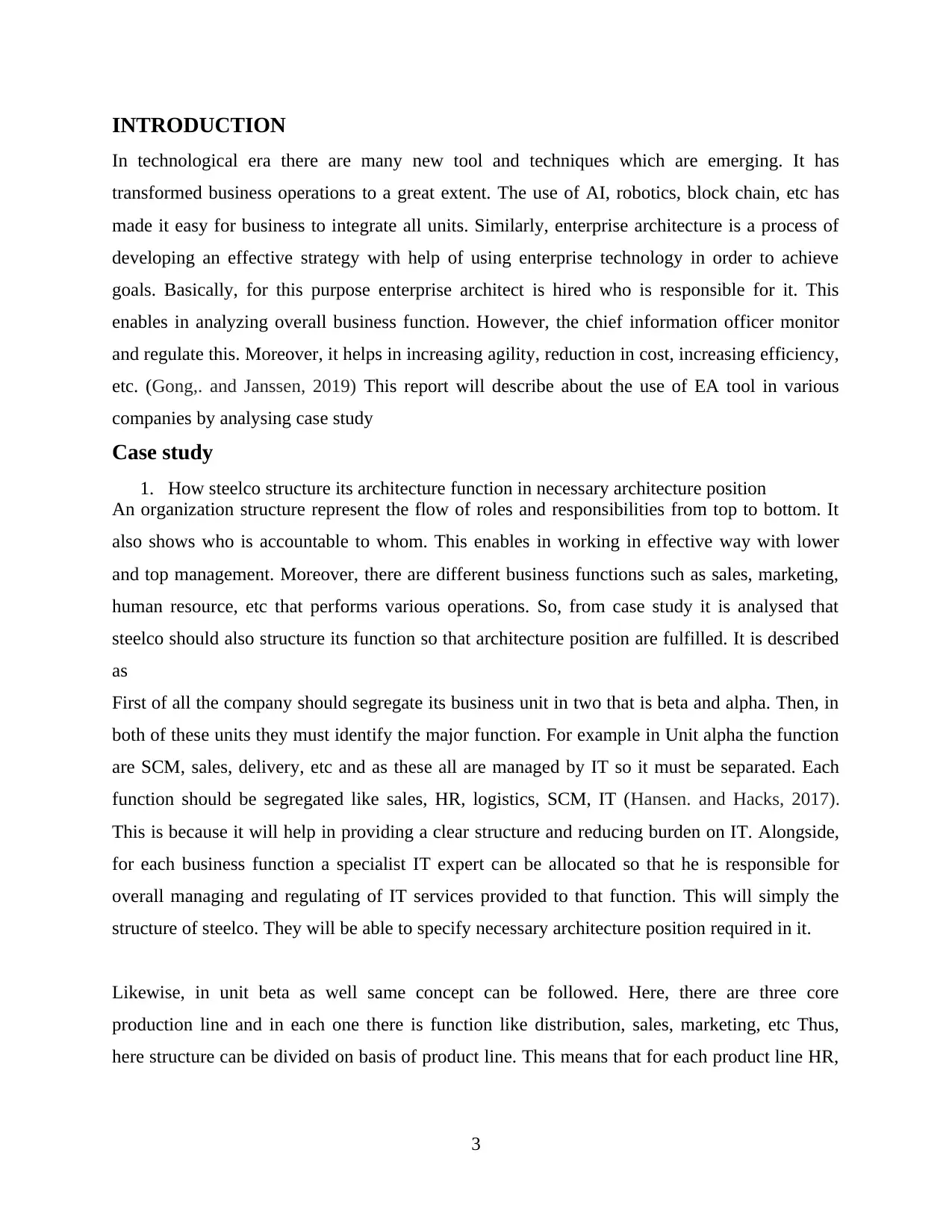
INTRODUCTION
In technological era there are many new tool and techniques which are emerging. It has
transformed business operations to a great extent. The use of AI, robotics, block chain, etc has
made it easy for business to integrate all units. Similarly, enterprise architecture is a process of
developing an effective strategy with help of using enterprise technology in order to achieve
goals. Basically, for this purpose enterprise architect is hired who is responsible for it. This
enables in analyzing overall business function. However, the chief information officer monitor
and regulate this. Moreover, it helps in increasing agility, reduction in cost, increasing efficiency,
etc. (Gong,. and Janssen, 2019) This report will describe about the use of EA tool in various
companies by analysing case study
Case study
1. How steelco structure its architecture function in necessary architecture position
An organization structure represent the flow of roles and responsibilities from top to bottom. It
also shows who is accountable to whom. This enables in working in effective way with lower
and top management. Moreover, there are different business functions such as sales, marketing,
human resource, etc that performs various operations. So, from case study it is analysed that
steelco should also structure its function so that architecture position are fulfilled. It is described
as
First of all the company should segregate its business unit in two that is beta and alpha. Then, in
both of these units they must identify the major function. For example in Unit alpha the function
are SCM, sales, delivery, etc and as these all are managed by IT so it must be separated. Each
function should be segregated like sales, HR, logistics, SCM, IT (Hansen. and Hacks, 2017).
This is because it will help in providing a clear structure and reducing burden on IT. Alongside,
for each business function a specialist IT expert can be allocated so that he is responsible for
overall managing and regulating of IT services provided to that function. This will simply the
structure of steelco. They will be able to specify necessary architecture position required in it.
Likewise, in unit beta as well same concept can be followed. Here, there are three core
production line and in each one there is function like distribution, sales, marketing, etc Thus,
here structure can be divided on basis of product line. This means that for each product line HR,
3
In technological era there are many new tool and techniques which are emerging. It has
transformed business operations to a great extent. The use of AI, robotics, block chain, etc has
made it easy for business to integrate all units. Similarly, enterprise architecture is a process of
developing an effective strategy with help of using enterprise technology in order to achieve
goals. Basically, for this purpose enterprise architect is hired who is responsible for it. This
enables in analyzing overall business function. However, the chief information officer monitor
and regulate this. Moreover, it helps in increasing agility, reduction in cost, increasing efficiency,
etc. (Gong,. and Janssen, 2019) This report will describe about the use of EA tool in various
companies by analysing case study
Case study
1. How steelco structure its architecture function in necessary architecture position
An organization structure represent the flow of roles and responsibilities from top to bottom. It
also shows who is accountable to whom. This enables in working in effective way with lower
and top management. Moreover, there are different business functions such as sales, marketing,
human resource, etc that performs various operations. So, from case study it is analysed that
steelco should also structure its function so that architecture position are fulfilled. It is described
as
First of all the company should segregate its business unit in two that is beta and alpha. Then, in
both of these units they must identify the major function. For example in Unit alpha the function
are SCM, sales, delivery, etc and as these all are managed by IT so it must be separated. Each
function should be segregated like sales, HR, logistics, SCM, IT (Hansen. and Hacks, 2017).
This is because it will help in providing a clear structure and reducing burden on IT. Alongside,
for each business function a specialist IT expert can be allocated so that he is responsible for
overall managing and regulating of IT services provided to that function. This will simply the
structure of steelco. They will be able to specify necessary architecture position required in it.
Likewise, in unit beta as well same concept can be followed. Here, there are three core
production line and in each one there is function like distribution, sales, marketing, etc Thus,
here structure can be divided on basis of product line. This means that for each product line HR,
3
⊘ This is a preview!⊘
Do you want full access?
Subscribe today to unlock all pages.

Trusted by 1+ million students worldwide
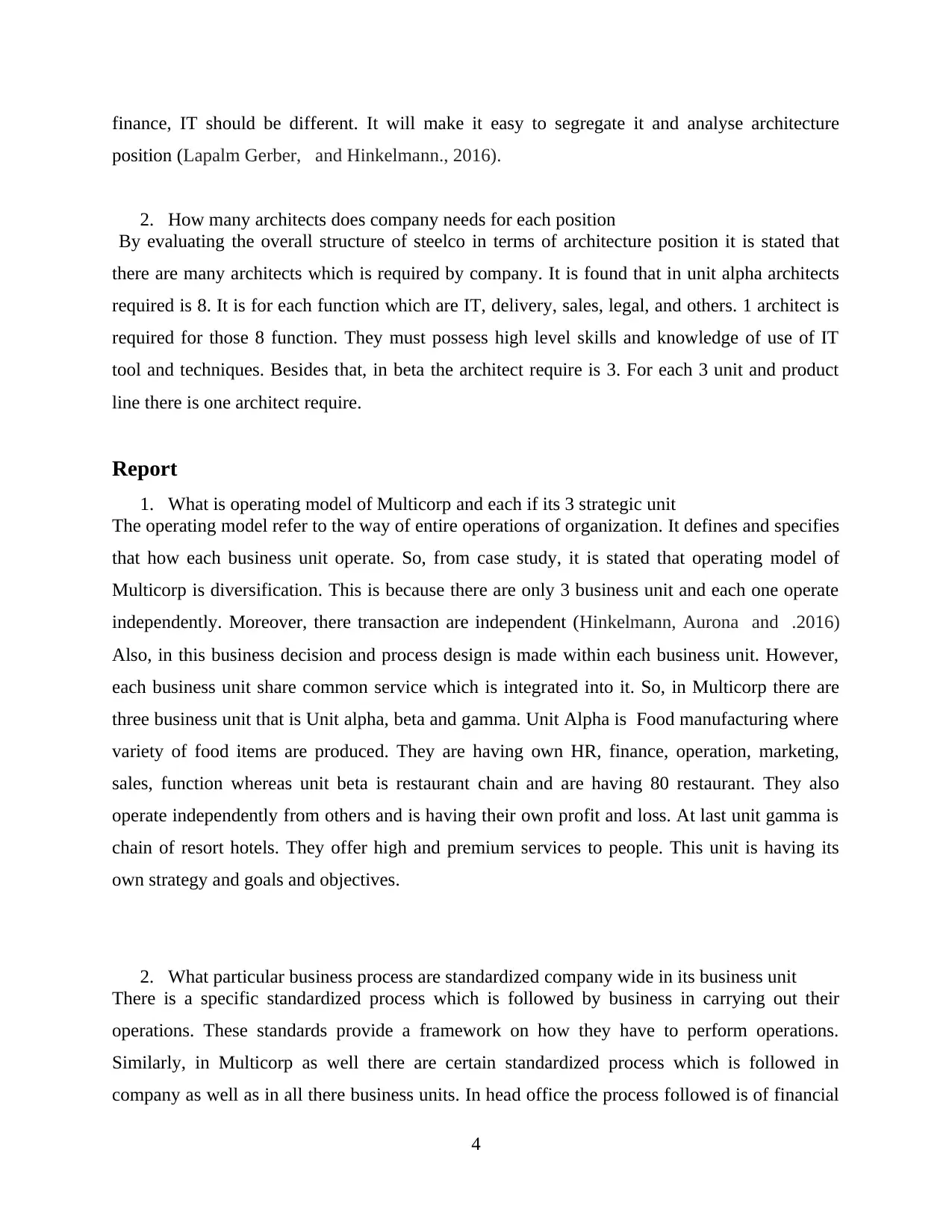
finance, IT should be different. It will make it easy to segregate it and analyse architecture
position (Lapalm Gerber, and Hinkelmann., 2016).
2. How many architects does company needs for each position
By evaluating the overall structure of steelco in terms of architecture position it is stated that
there are many architects which is required by company. It is found that in unit alpha architects
required is 8. It is for each function which are IT, delivery, sales, legal, and others. 1 architect is
required for those 8 function. They must possess high level skills and knowledge of use of IT
tool and techniques. Besides that, in beta the architect require is 3. For each 3 unit and product
line there is one architect require.
Report
1. What is operating model of Multicorp and each if its 3 strategic unit
The operating model refer to the way of entire operations of organization. It defines and specifies
that how each business unit operate. So, from case study, it is stated that operating model of
Multicorp is diversification. This is because there are only 3 business unit and each one operate
independently. Moreover, there transaction are independent (Hinkelmann, Aurona and .2016)
Also, in this business decision and process design is made within each business unit. However,
each business unit share common service which is integrated into it. So, in Multicorp there are
three business unit that is Unit alpha, beta and gamma. Unit Alpha is Food manufacturing where
variety of food items are produced. They are having own HR, finance, operation, marketing,
sales, function whereas unit beta is restaurant chain and are having 80 restaurant. They also
operate independently from others and is having their own profit and loss. At last unit gamma is
chain of resort hotels. They offer high and premium services to people. This unit is having its
own strategy and goals and objectives.
2. What particular business process are standardized company wide in its business unit
There is a specific standardized process which is followed by business in carrying out their
operations. These standards provide a framework on how they have to perform operations.
Similarly, in Multicorp as well there are certain standardized process which is followed in
company as well as in all there business units. In head office the process followed is of financial
4
position (Lapalm Gerber, and Hinkelmann., 2016).
2. How many architects does company needs for each position
By evaluating the overall structure of steelco in terms of architecture position it is stated that
there are many architects which is required by company. It is found that in unit alpha architects
required is 8. It is for each function which are IT, delivery, sales, legal, and others. 1 architect is
required for those 8 function. They must possess high level skills and knowledge of use of IT
tool and techniques. Besides that, in beta the architect require is 3. For each 3 unit and product
line there is one architect require.
Report
1. What is operating model of Multicorp and each if its 3 strategic unit
The operating model refer to the way of entire operations of organization. It defines and specifies
that how each business unit operate. So, from case study, it is stated that operating model of
Multicorp is diversification. This is because there are only 3 business unit and each one operate
independently. Moreover, there transaction are independent (Hinkelmann, Aurona and .2016)
Also, in this business decision and process design is made within each business unit. However,
each business unit share common service which is integrated into it. So, in Multicorp there are
three business unit that is Unit alpha, beta and gamma. Unit Alpha is Food manufacturing where
variety of food items are produced. They are having own HR, finance, operation, marketing,
sales, function whereas unit beta is restaurant chain and are having 80 restaurant. They also
operate independently from others and is having their own profit and loss. At last unit gamma is
chain of resort hotels. They offer high and premium services to people. This unit is having its
own strategy and goals and objectives.
2. What particular business process are standardized company wide in its business unit
There is a specific standardized process which is followed by business in carrying out their
operations. These standards provide a framework on how they have to perform operations.
Similarly, in Multicorp as well there are certain standardized process which is followed in
company as well as in all there business units. In head office the process followed is of financial
4
Paraphrase This Document
Need a fresh take? Get an instant paraphrase of this document with our AI Paraphraser
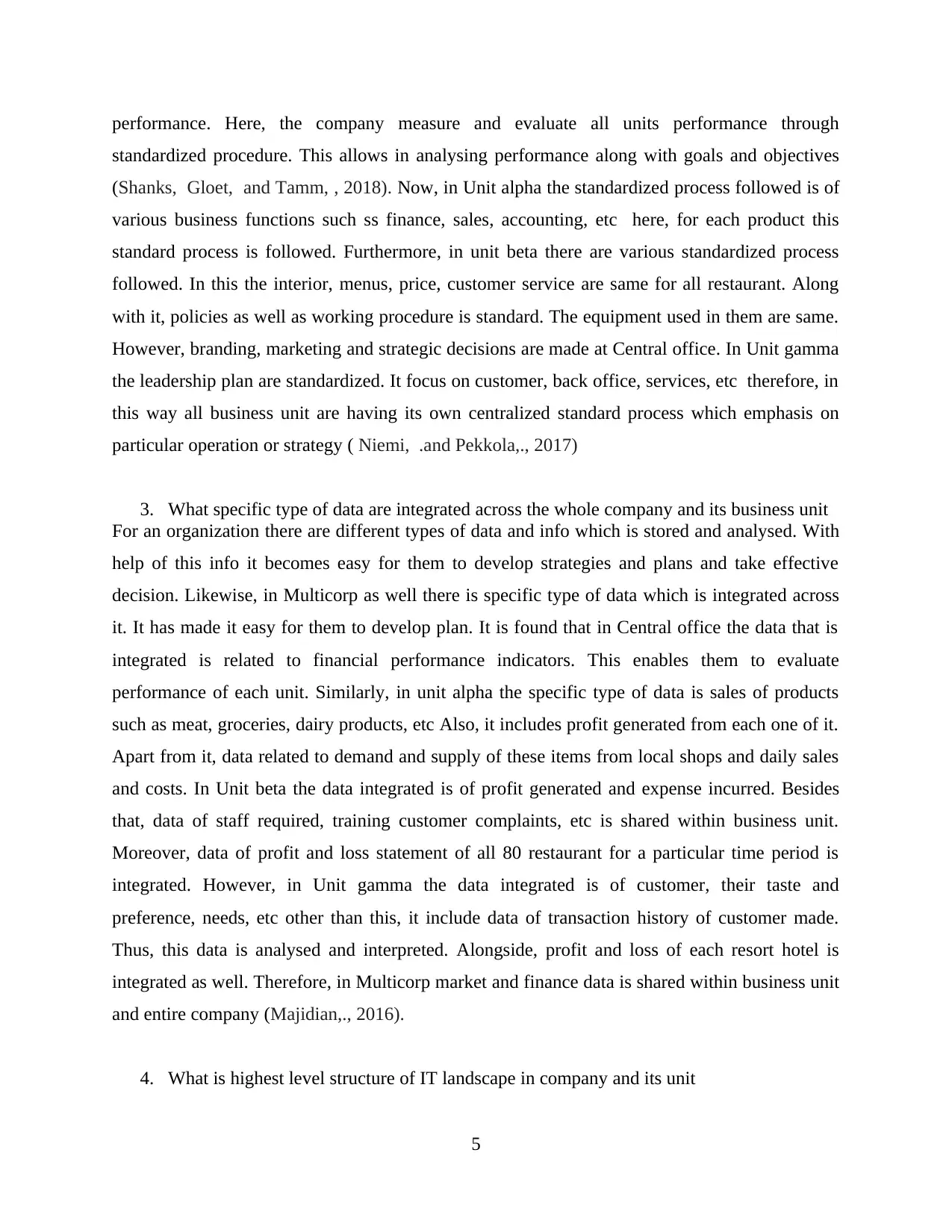
performance. Here, the company measure and evaluate all units performance through
standardized procedure. This allows in analysing performance along with goals and objectives
(Shanks, Gloet, and Tamm, , 2018). Now, in Unit alpha the standardized process followed is of
various business functions such ss finance, sales, accounting, etc here, for each product this
standard process is followed. Furthermore, in unit beta there are various standardized process
followed. In this the interior, menus, price, customer service are same for all restaurant. Along
with it, policies as well as working procedure is standard. The equipment used in them are same.
However, branding, marketing and strategic decisions are made at Central office. In Unit gamma
the leadership plan are standardized. It focus on customer, back office, services, etc therefore, in
this way all business unit are having its own centralized standard process which emphasis on
particular operation or strategy ( Niemi, .and Pekkola,., 2017)
3. What specific type of data are integrated across the whole company and its business unit
For an organization there are different types of data and info which is stored and analysed. With
help of this info it becomes easy for them to develop strategies and plans and take effective
decision. Likewise, in Multicorp as well there is specific type of data which is integrated across
it. It has made it easy for them to develop plan. It is found that in Central office the data that is
integrated is related to financial performance indicators. This enables them to evaluate
performance of each unit. Similarly, in unit alpha the specific type of data is sales of products
such as meat, groceries, dairy products, etc Also, it includes profit generated from each one of it.
Apart from it, data related to demand and supply of these items from local shops and daily sales
and costs. In Unit beta the data integrated is of profit generated and expense incurred. Besides
that, data of staff required, training customer complaints, etc is shared within business unit.
Moreover, data of profit and loss statement of all 80 restaurant for a particular time period is
integrated. However, in Unit gamma the data integrated is of customer, their taste and
preference, needs, etc other than this, it include data of transaction history of customer made.
Thus, this data is analysed and interpreted. Alongside, profit and loss of each resort hotel is
integrated as well. Therefore, in Multicorp market and finance data is shared within business unit
and entire company (Majidian,., 2016).
4. What is highest level structure of IT landscape in company and its unit
5
standardized procedure. This allows in analysing performance along with goals and objectives
(Shanks, Gloet, and Tamm, , 2018). Now, in Unit alpha the standardized process followed is of
various business functions such ss finance, sales, accounting, etc here, for each product this
standard process is followed. Furthermore, in unit beta there are various standardized process
followed. In this the interior, menus, price, customer service are same for all restaurant. Along
with it, policies as well as working procedure is standard. The equipment used in them are same.
However, branding, marketing and strategic decisions are made at Central office. In Unit gamma
the leadership plan are standardized. It focus on customer, back office, services, etc therefore, in
this way all business unit are having its own centralized standard process which emphasis on
particular operation or strategy ( Niemi, .and Pekkola,., 2017)
3. What specific type of data are integrated across the whole company and its business unit
For an organization there are different types of data and info which is stored and analysed. With
help of this info it becomes easy for them to develop strategies and plans and take effective
decision. Likewise, in Multicorp as well there is specific type of data which is integrated across
it. It has made it easy for them to develop plan. It is found that in Central office the data that is
integrated is related to financial performance indicators. This enables them to evaluate
performance of each unit. Similarly, in unit alpha the specific type of data is sales of products
such as meat, groceries, dairy products, etc Also, it includes profit generated from each one of it.
Apart from it, data related to demand and supply of these items from local shops and daily sales
and costs. In Unit beta the data integrated is of profit generated and expense incurred. Besides
that, data of staff required, training customer complaints, etc is shared within business unit.
Moreover, data of profit and loss statement of all 80 restaurant for a particular time period is
integrated. However, in Unit gamma the data integrated is of customer, their taste and
preference, needs, etc other than this, it include data of transaction history of customer made.
Thus, this data is analysed and interpreted. Alongside, profit and loss of each resort hotel is
integrated as well. Therefore, in Multicorp market and finance data is shared within business unit
and entire company (Majidian,., 2016).
4. What is highest level structure of IT landscape in company and its unit
5
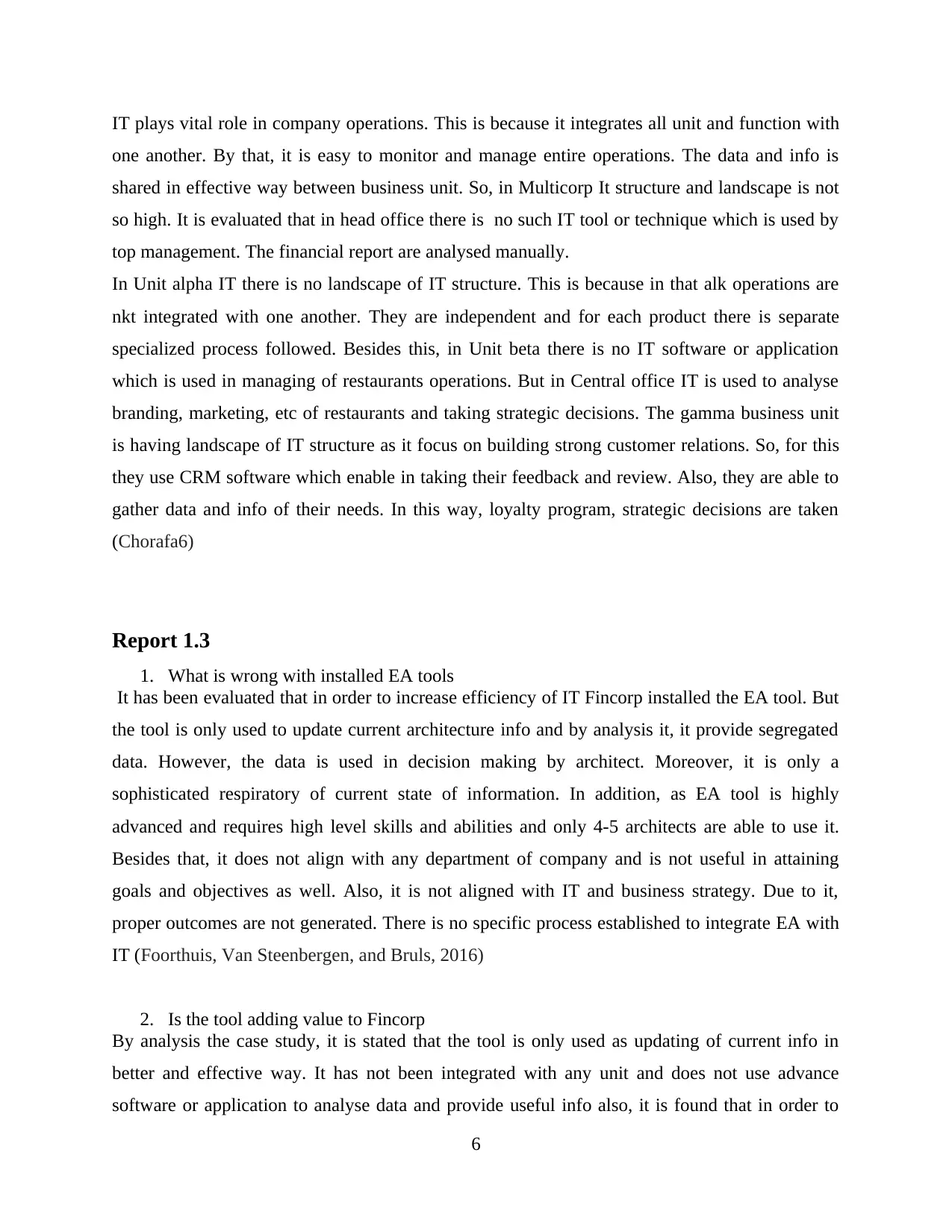
IT plays vital role in company operations. This is because it integrates all unit and function with
one another. By that, it is easy to monitor and manage entire operations. The data and info is
shared in effective way between business unit. So, in Multicorp It structure and landscape is not
so high. It is evaluated that in head office there is no such IT tool or technique which is used by
top management. The financial report are analysed manually.
In Unit alpha IT there is no landscape of IT structure. This is because in that alk operations are
nkt integrated with one another. They are independent and for each product there is separate
specialized process followed. Besides this, in Unit beta there is no IT software or application
which is used in managing of restaurants operations. But in Central office IT is used to analyse
branding, marketing, etc of restaurants and taking strategic decisions. The gamma business unit
is having landscape of IT structure as it focus on building strong customer relations. So, for this
they use CRM software which enable in taking their feedback and review. Also, they are able to
gather data and info of their needs. In this way, loyalty program, strategic decisions are taken
(Chorafa6)
Report 1.3
1. What is wrong with installed EA tools
It has been evaluated that in order to increase efficiency of IT Fincorp installed the EA tool. But
the tool is only used to update current architecture info and by analysis it, it provide segregated
data. However, the data is used in decision making by architect. Moreover, it is only a
sophisticated respiratory of current state of information. In addition, as EA tool is highly
advanced and requires high level skills and abilities and only 4-5 architects are able to use it.
Besides that, it does not align with any department of company and is not useful in attaining
goals and objectives as well. Also, it is not aligned with IT and business strategy. Due to it,
proper outcomes are not generated. There is no specific process established to integrate EA with
IT (Foorthuis, Van Steenbergen, and Bruls, 2016)
2. Is the tool adding value to Fincorp
By analysis the case study, it is stated that the tool is only used as updating of current info in
better and effective way. It has not been integrated with any unit and does not use advance
software or application to analyse data and provide useful info also, it is found that in order to
6
one another. By that, it is easy to monitor and manage entire operations. The data and info is
shared in effective way between business unit. So, in Multicorp It structure and landscape is not
so high. It is evaluated that in head office there is no such IT tool or technique which is used by
top management. The financial report are analysed manually.
In Unit alpha IT there is no landscape of IT structure. This is because in that alk operations are
nkt integrated with one another. They are independent and for each product there is separate
specialized process followed. Besides this, in Unit beta there is no IT software or application
which is used in managing of restaurants operations. But in Central office IT is used to analyse
branding, marketing, etc of restaurants and taking strategic decisions. The gamma business unit
is having landscape of IT structure as it focus on building strong customer relations. So, for this
they use CRM software which enable in taking their feedback and review. Also, they are able to
gather data and info of their needs. In this way, loyalty program, strategic decisions are taken
(Chorafa6)
Report 1.3
1. What is wrong with installed EA tools
It has been evaluated that in order to increase efficiency of IT Fincorp installed the EA tool. But
the tool is only used to update current architecture info and by analysis it, it provide segregated
data. However, the data is used in decision making by architect. Moreover, it is only a
sophisticated respiratory of current state of information. In addition, as EA tool is highly
advanced and requires high level skills and abilities and only 4-5 architects are able to use it.
Besides that, it does not align with any department of company and is not useful in attaining
goals and objectives as well. Also, it is not aligned with IT and business strategy. Due to it,
proper outcomes are not generated. There is no specific process established to integrate EA with
IT (Foorthuis, Van Steenbergen, and Bruls, 2016)
2. Is the tool adding value to Fincorp
By analysis the case study, it is stated that the tool is only used as updating of current info in
better and effective way. It has not been integrated with any unit and does not use advance
software or application to analyse data and provide useful info also, it is found that in order to
6
⊘ This is a preview!⊘
Do you want full access?
Subscribe today to unlock all pages.

Trusted by 1+ million students worldwide
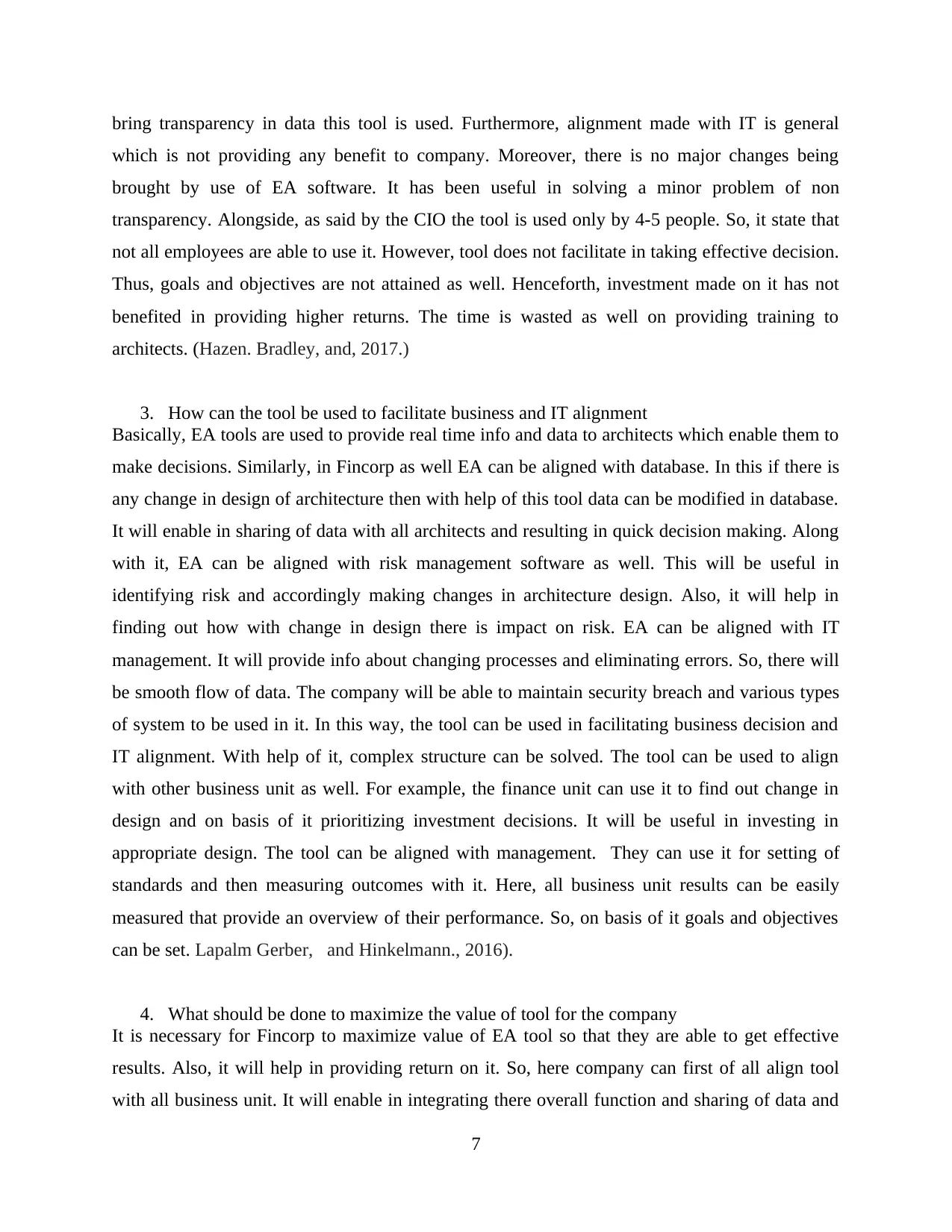
bring transparency in data this tool is used. Furthermore, alignment made with IT is general
which is not providing any benefit to company. Moreover, there is no major changes being
brought by use of EA software. It has been useful in solving a minor problem of non
transparency. Alongside, as said by the CIO the tool is used only by 4-5 people. So, it state that
not all employees are able to use it. However, tool does not facilitate in taking effective decision.
Thus, goals and objectives are not attained as well. Henceforth, investment made on it has not
benefited in providing higher returns. The time is wasted as well on providing training to
architects. (Hazen. Bradley, and, 2017.)
3. How can the tool be used to facilitate business and IT alignment
Basically, EA tools are used to provide real time info and data to architects which enable them to
make decisions. Similarly, in Fincorp as well EA can be aligned with database. In this if there is
any change in design of architecture then with help of this tool data can be modified in database.
It will enable in sharing of data with all architects and resulting in quick decision making. Along
with it, EA can be aligned with risk management software as well. This will be useful in
identifying risk and accordingly making changes in architecture design. Also, it will help in
finding out how with change in design there is impact on risk. EA can be aligned with IT
management. It will provide info about changing processes and eliminating errors. So, there will
be smooth flow of data. The company will be able to maintain security breach and various types
of system to be used in it. In this way, the tool can be used in facilitating business decision and
IT alignment. With help of it, complex structure can be solved. The tool can be used to align
with other business unit as well. For example, the finance unit can use it to find out change in
design and on basis of it prioritizing investment decisions. It will be useful in investing in
appropriate design. The tool can be aligned with management. They can use it for setting of
standards and then measuring outcomes with it. Here, all business unit results can be easily
measured that provide an overview of their performance. So, on basis of it goals and objectives
can be set. Lapalm Gerber, and Hinkelmann., 2016).
4. What should be done to maximize the value of tool for the company
It is necessary for Fincorp to maximize value of EA tool so that they are able to get effective
results. Also, it will help in providing return on it. So, here company can first of all align tool
with all business unit. It will enable in integrating there overall function and sharing of data and
7
which is not providing any benefit to company. Moreover, there is no major changes being
brought by use of EA software. It has been useful in solving a minor problem of non
transparency. Alongside, as said by the CIO the tool is used only by 4-5 people. So, it state that
not all employees are able to use it. However, tool does not facilitate in taking effective decision.
Thus, goals and objectives are not attained as well. Henceforth, investment made on it has not
benefited in providing higher returns. The time is wasted as well on providing training to
architects. (Hazen. Bradley, and, 2017.)
3. How can the tool be used to facilitate business and IT alignment
Basically, EA tools are used to provide real time info and data to architects which enable them to
make decisions. Similarly, in Fincorp as well EA can be aligned with database. In this if there is
any change in design of architecture then with help of this tool data can be modified in database.
It will enable in sharing of data with all architects and resulting in quick decision making. Along
with it, EA can be aligned with risk management software as well. This will be useful in
identifying risk and accordingly making changes in architecture design. Also, it will help in
finding out how with change in design there is impact on risk. EA can be aligned with IT
management. It will provide info about changing processes and eliminating errors. So, there will
be smooth flow of data. The company will be able to maintain security breach and various types
of system to be used in it. In this way, the tool can be used in facilitating business decision and
IT alignment. With help of it, complex structure can be solved. The tool can be used to align
with other business unit as well. For example, the finance unit can use it to find out change in
design and on basis of it prioritizing investment decisions. It will be useful in investing in
appropriate design. The tool can be aligned with management. They can use it for setting of
standards and then measuring outcomes with it. Here, all business unit results can be easily
measured that provide an overview of their performance. So, on basis of it goals and objectives
can be set. Lapalm Gerber, and Hinkelmann., 2016).
4. What should be done to maximize the value of tool for the company
It is necessary for Fincorp to maximize value of EA tool so that they are able to get effective
results. Also, it will help in providing return on it. So, here company can first of all align tool
with all business unit. It will enable in integrating there overall function and sharing of data and
7
Paraphrase This Document
Need a fresh take? Get an instant paraphrase of this document with our AI Paraphraser
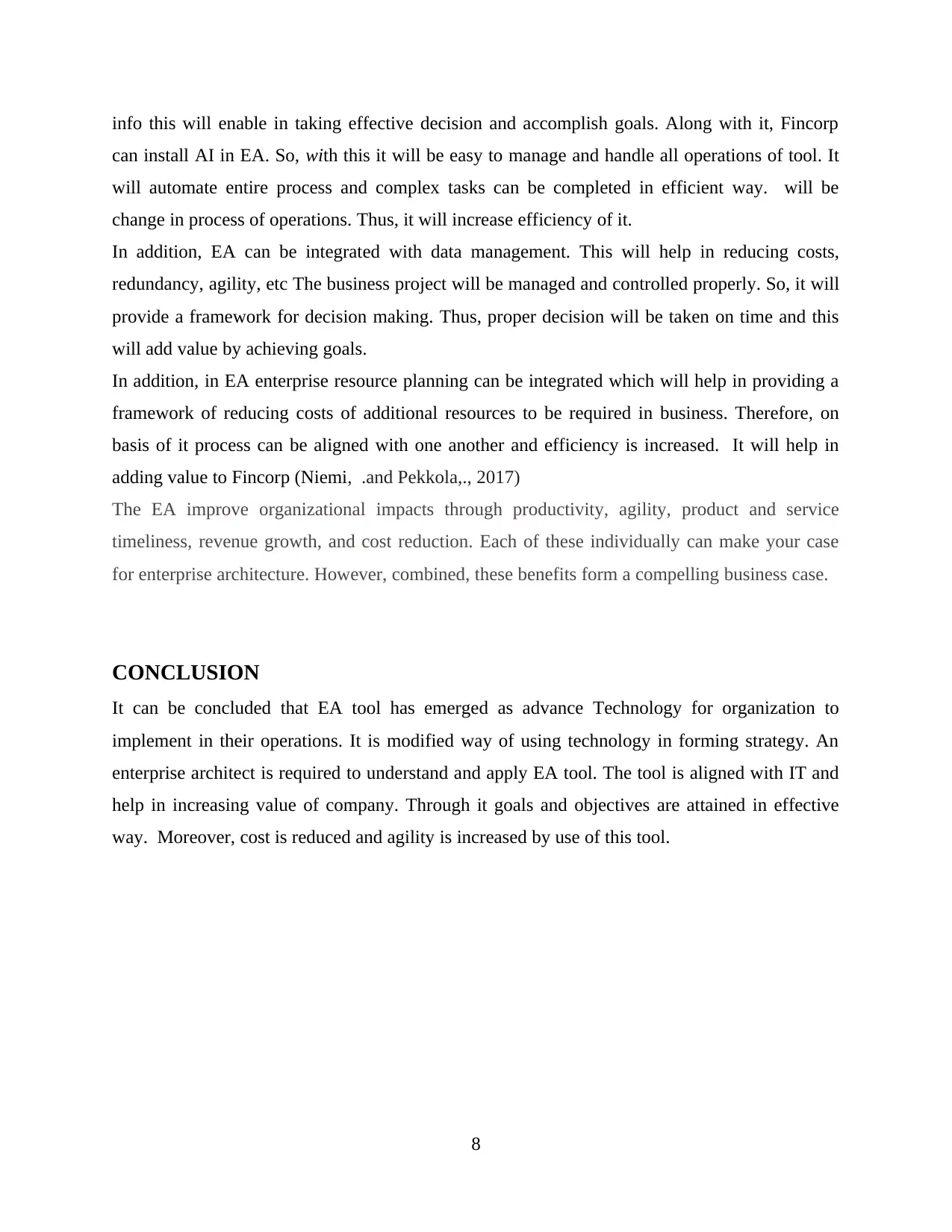
info this will enable in taking effective decision and accomplish goals. Along with it, Fincorp
can install AI in EA. So, with this it will be easy to manage and handle all operations of tool. It
will automate entire process and complex tasks can be completed in efficient way. will be
change in process of operations. Thus, it will increase efficiency of it.
In addition, EA can be integrated with data management. This will help in reducing costs,
redundancy, agility, etc The business project will be managed and controlled properly. So, it will
provide a framework for decision making. Thus, proper decision will be taken on time and this
will add value by achieving goals.
In addition, in EA enterprise resource planning can be integrated which will help in providing a
framework of reducing costs of additional resources to be required in business. Therefore, on
basis of it process can be aligned with one another and efficiency is increased. It will help in
adding value to Fincorp (Niemi, .and Pekkola,., 2017)
The EA improve organizational impacts through productivity, agility, product and service
timeliness, revenue growth, and cost reduction. Each of these individually can make your case
for enterprise architecture. However, combined, these benefits form a compelling business case.
CONCLUSION
It can be concluded that EA tool has emerged as advance Technology for organization to
implement in their operations. It is modified way of using technology in forming strategy. An
enterprise architect is required to understand and apply EA tool. The tool is aligned with IT and
help in increasing value of company. Through it goals and objectives are attained in effective
way. Moreover, cost is reduced and agility is increased by use of this tool.
8
can install AI in EA. So, with this it will be easy to manage and handle all operations of tool. It
will automate entire process and complex tasks can be completed in efficient way. will be
change in process of operations. Thus, it will increase efficiency of it.
In addition, EA can be integrated with data management. This will help in reducing costs,
redundancy, agility, etc The business project will be managed and controlled properly. So, it will
provide a framework for decision making. Thus, proper decision will be taken on time and this
will add value by achieving goals.
In addition, in EA enterprise resource planning can be integrated which will help in providing a
framework of reducing costs of additional resources to be required in business. Therefore, on
basis of it process can be aligned with one another and efficiency is increased. It will help in
adding value to Fincorp (Niemi, .and Pekkola,., 2017)
The EA improve organizational impacts through productivity, agility, product and service
timeliness, revenue growth, and cost reduction. Each of these individually can make your case
for enterprise architecture. However, combined, these benefits form a compelling business case.
CONCLUSION
It can be concluded that EA tool has emerged as advance Technology for organization to
implement in their operations. It is modified way of using technology in forming strategy. An
enterprise architect is required to understand and apply EA tool. The tool is aligned with IT and
help in increasing value of company. Through it goals and objectives are attained in effective
way. Moreover, cost is reduced and agility is increased by use of this tool.
8

REFERENCES
Books and journals
9
Books and journals
9
⊘ This is a preview!⊘
Do you want full access?
Subscribe today to unlock all pages.

Trusted by 1+ million students worldwide
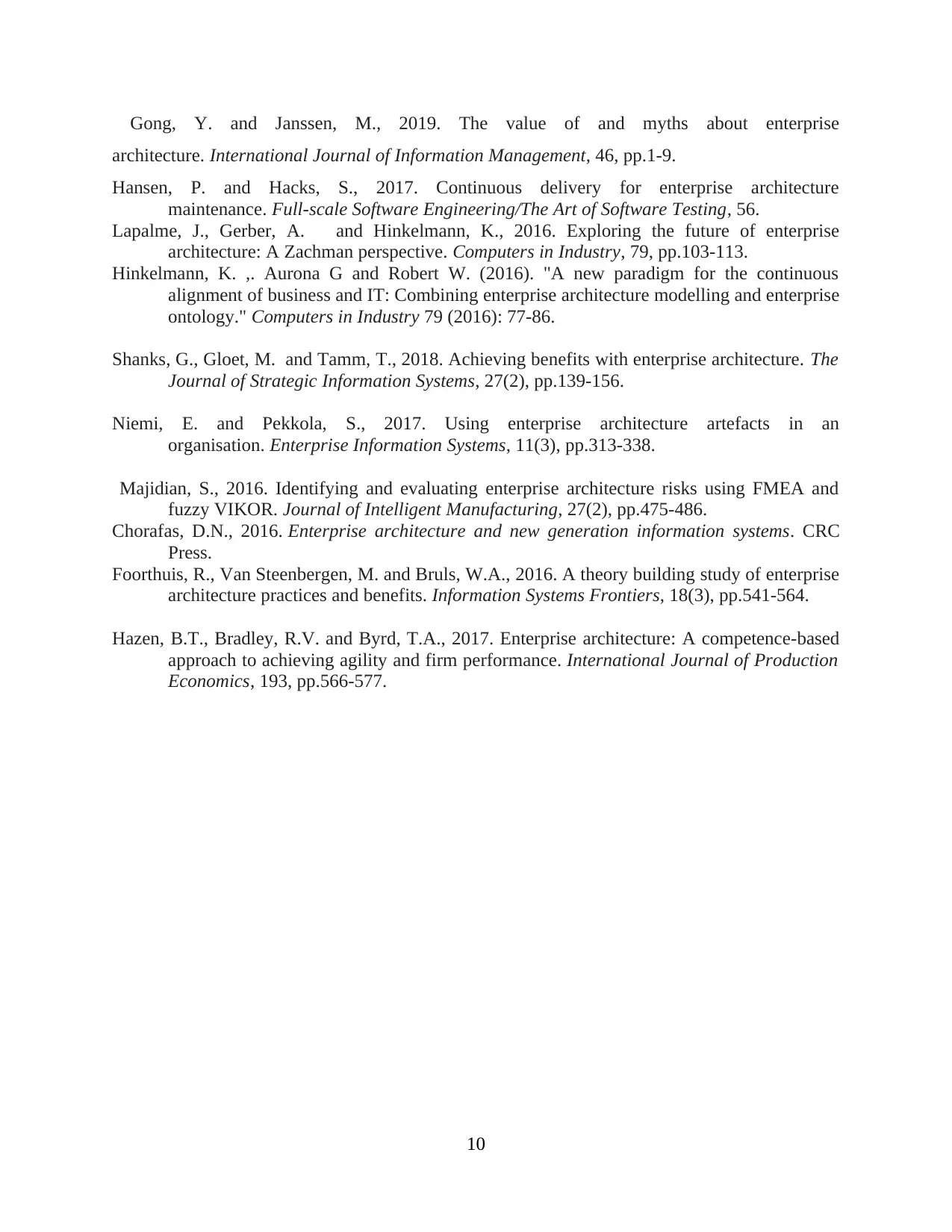
Gong, Y. and Janssen, M., 2019. The value of and myths about enterprise
architecture. International Journal of Information Management, 46, pp.1-9.
Hansen, P. and Hacks, S., 2017. Continuous delivery for enterprise architecture
maintenance. Full-scale Software Engineering/The Art of Software Testing, 56.
Lapalme, J., Gerber, A. and Hinkelmann, K., 2016. Exploring the future of enterprise
architecture: A Zachman perspective. Computers in Industry, 79, pp.103-113.
Hinkelmann, K. ,. Aurona G and Robert W. (2016). "A new paradigm for the continuous
alignment of business and IT: Combining enterprise architecture modelling and enterprise
ontology." Computers in Industry 79 (2016): 77-86.
Shanks, G., Gloet, M. and Tamm, T., 2018. Achieving benefits with enterprise architecture. The
Journal of Strategic Information Systems, 27(2), pp.139-156.
Niemi, E. and Pekkola, S., 2017. Using enterprise architecture artefacts in an
organisation. Enterprise Information Systems, 11(3), pp.313-338.
Majidian, S., 2016. Identifying and evaluating enterprise architecture risks using FMEA and
fuzzy VIKOR. Journal of Intelligent Manufacturing, 27(2), pp.475-486.
Chorafas, D.N., 2016. Enterprise architecture and new generation information systems. CRC
Press.
Foorthuis, R., Van Steenbergen, M. and Bruls, W.A., 2016. A theory building study of enterprise
architecture practices and benefits. Information Systems Frontiers, 18(3), pp.541-564.
Hazen, B.T., Bradley, R.V. and Byrd, T.A., 2017. Enterprise architecture: A competence-based
approach to achieving agility and firm performance. International Journal of Production
Economics, 193, pp.566-577.
10
architecture. International Journal of Information Management, 46, pp.1-9.
Hansen, P. and Hacks, S., 2017. Continuous delivery for enterprise architecture
maintenance. Full-scale Software Engineering/The Art of Software Testing, 56.
Lapalme, J., Gerber, A. and Hinkelmann, K., 2016. Exploring the future of enterprise
architecture: A Zachman perspective. Computers in Industry, 79, pp.103-113.
Hinkelmann, K. ,. Aurona G and Robert W. (2016). "A new paradigm for the continuous
alignment of business and IT: Combining enterprise architecture modelling and enterprise
ontology." Computers in Industry 79 (2016): 77-86.
Shanks, G., Gloet, M. and Tamm, T., 2018. Achieving benefits with enterprise architecture. The
Journal of Strategic Information Systems, 27(2), pp.139-156.
Niemi, E. and Pekkola, S., 2017. Using enterprise architecture artefacts in an
organisation. Enterprise Information Systems, 11(3), pp.313-338.
Majidian, S., 2016. Identifying and evaluating enterprise architecture risks using FMEA and
fuzzy VIKOR. Journal of Intelligent Manufacturing, 27(2), pp.475-486.
Chorafas, D.N., 2016. Enterprise architecture and new generation information systems. CRC
Press.
Foorthuis, R., Van Steenbergen, M. and Bruls, W.A., 2016. A theory building study of enterprise
architecture practices and benefits. Information Systems Frontiers, 18(3), pp.541-564.
Hazen, B.T., Bradley, R.V. and Byrd, T.A., 2017. Enterprise architecture: A competence-based
approach to achieving agility and firm performance. International Journal of Production
Economics, 193, pp.566-577.
10
1 out of 10
Related Documents
Your All-in-One AI-Powered Toolkit for Academic Success.
+13062052269
info@desklib.com
Available 24*7 on WhatsApp / Email
![[object Object]](/_next/static/media/star-bottom.7253800d.svg)
Unlock your academic potential
Copyright © 2020–2025 A2Z Services. All Rights Reserved. Developed and managed by ZUCOL.





